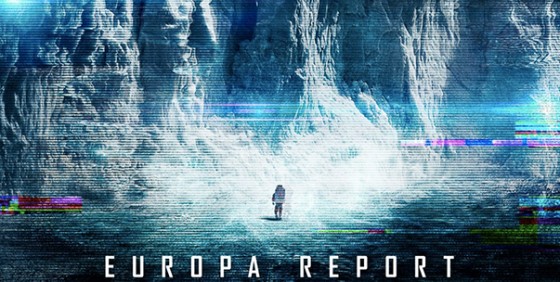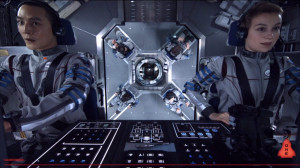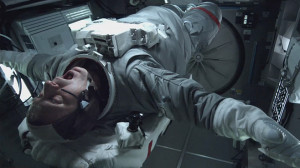Aside from Earth, where in the known universe are we most likely place to find life? If you guessed Mars…that’s a good guess. But on Earth, where there’s liquid water, there’s life, and where you’ll find the most liquid water off of Earth is on Europa, one of the moons of Jupiter. We have known this for years, but Arthur C. Clarke guessed it still earlier than that in his novel 2010: Odyssey Two. There’s a subplot in that novel concerning a spacecraft that lands on Europa and finds the life and water they were looking for, but also a grim fate. The film Europa Report could almost be an adaptation of that story.
I happened upon the Blu-ray of this movie just the other week. I’d heard very little about it; I knew it was a small indie film from last year and that it was well-reviewed. So I had the rare sensation when putting it in my player of not knowing what I was in for.
The film starts with a bit of exposition about Europa and the genesis of a manned expedition to get there, then launches into the “recently declassified” footage from the spacecraft. Then we get some ominous foreshadowing of death and destruction. What was in store for me? Would a serial killer stalk the halls of this craft, like Sunshine? Would a breach of space-time open a gateway to Lovecraftian horror, like Event Horizon? Would godlike aliens carelessly rend these fragile souls like in Mission to Mars?
But Europa Report is not so derivative. It plays with these expectations, I expect deliberately, but it is not a work of horror or fantasy. In fact it is that rarest of all beasts: a true hard science-fiction movie. And it is no less tense for it.
The movie establishes several points with elegance very early on. The entire mission is presented in “found-footage” format. It’s introduced by “new” footage of the CEO who launched the mission (Embeth Davidtz) and one of her scientists. We immediately learn that there was a fatality early in the mission and a loss of contact with Earth at around that same time. It is alternately hinted that the spacecraft did not return at all, or that only a small number of the crew including the pilot did return and were interviewed later.
After this the movie settles into a somewhat chronological order, barring two extended flashbacks. We first meet the crew strung-out after two years in deep space, but we’re quickly re-introduced to them during the first three days of the mission. The lost crew member (Sharlto Copley, rocking a fairly solid US accent) was well-loved, but even as he raised the crew’s spirits, he struggled with regret for leaving behind his wife and child. Later, after the team lands on Europa, we get the second flashback that depicts his fate.
But even before we know why, their dead crewmate hangs over the shipmates like a specter as they reach Europa. Now comprising one pilot, one engineer, and several scientists, the crew descends on the planet, but a minor technical flub and incomplete information about the surface result in an off-target landing. While a minor incident, it is exactly these minor errors and ignorance that add up throughout the film. In an environment so instantly lethal, every action is perilous. The ship rests atop melting ice, with endless black water below. Tremors and heat flashes threaten this precarious surface, and dangerous radiation spikes hit every few minutes (ingeniously, these distort the image of every camera on the ship as they occur). And the radiation isn’t just coming from Jupiter as they expected–something is below them as well.
Any more plot summary will seriously ruin this thing, but it’s at around this time that the biologist Katya (Karolina Wydra) states the central theme of the film: “Compared to the breadth of knowledge yet to be known… what does your life actually matter?” One of the most charming things about the film, to me, is that it depicted the reaction of scientists to a new world in precisely the way that Prometheus didn’t; intensely excited and curious, yet ever professional and cautious. As situations develop, each is discussed and balance is sought between the collection of data, the safety of the ship, and the safety of each individual crew member. One might accuse the film of being “sterile” on the surface, like 2001: A Space Odyssey, but the intimate camera work and skilled acting prevents this contention. Their dialogue is often technical, but their emotions primal and relatable. These are real human beings, feeling wonder, hope, and terror in equal measure. In comparison to other space movies, the relative absence of anyone losing their shit is actually refreshing.
While very much its own movie, there’s DNA of several other space adventures in Europa Report. The obvious comparison, perhaps regrettably, is the low budget found-footage horror film Apollo 18, but the phenomena on Europa are strongly reminiscent of elements unique to the book 2010 and its film adaptation. The international crew and their dynamics feel a bit like Sunshine, and the spacecraft, while clearly inspired by the filmmakers’ own research, also has a large rotating section that reminds one of the Colonel Leonov from 2010. The approach to filming the spacewalking astronauts seems inspired by Iron Man, and a key sequence plays out a bit like a reversed-angle version of one from 2001.
Hopefully other films will observe how this film creates a surpassingly realistic space journey on an extremely small budget. Most Hollywood films do not attempt to simulate microgravity, claiming cost reasons, yet this one never fails to show the astronauts floating in non-rotating parts of the ship. Whatever techniques they developed are both low-cost and effective, so big-budget space films no longer have an excuse. This is actually an important innovation, as not every film can afford the services of the “Vomit Comet” airplane, and I believe the simulation was accomplished by digitally painting out props such as balance balls and wires. In general the film demonstrates the potential of modern visual effects to enhance low-budget indie films. We are starting to get to the point in digital animation where artistry is far more important than horsepower.
Europa Report‘s commitment to hard sci-fi and the empiricism, rationalism, and humanism of the characters make this a uniquely inspiring film. It’s rare to see a film glorify such a level of sacrifice for the pursuit of pure research and philosophical fulfillment, not to save people’s lives or foil some enemy. Despite their tiny ship and limited fuel, this is perhaps the purest expression of the spirit of the original Star Trek that we’ve seen in years.




